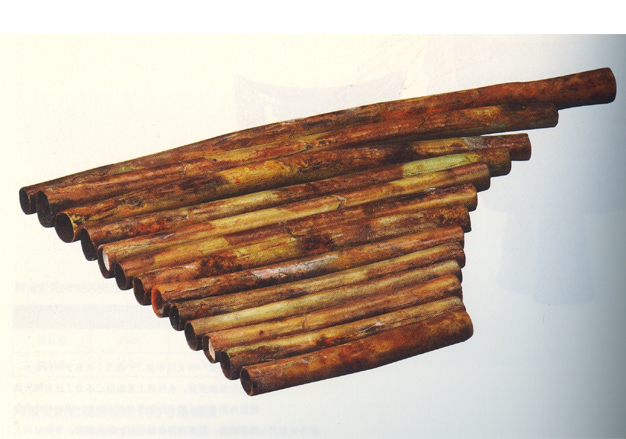Changzikou Tomb, excavated in Taiqinggong, Luyi county, Henan, in 1997, is a two-aisle tomb built in the early Western Zhou Dynasty with a plan resembling the Chinese character zhong (中). Over 1,000 burial objects were discovered. Altogether 4 bone panpipes were unearthed, of which the one numbered M1:112 is relatively intact. A typical 13-pipe panpipe, it is also the best-preserved, most exquisite one with the most bone pipes. When unearthed in the south of the west coffin chamber, the instrument comprising 13 bone pipes of descending lengths looked translucent with a jade-like hue. The pipes were made from bird leg bones. Besides, the panpipe also bore traces of an inverted V-shaped ribbon. From this archaeologists have inferred that the bone pipes were bound together with a wide ribbon. When discovered, it lay on another bone panpipe. Its hollow pipes were broken and filled with silt.
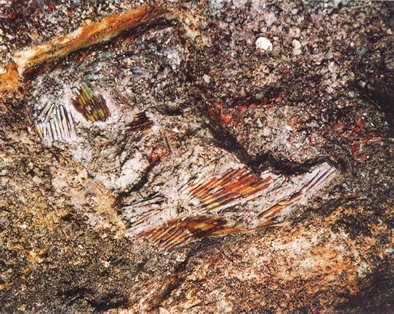
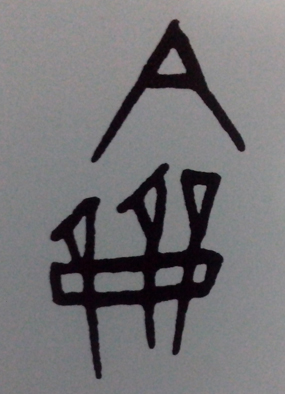
As recorded in the original excavation report, five panpipes were unearthed. However, it was found later that one of them had been mistaken for two because of the displacement caused by a tomb chamber cave-in.
Situated at the site of Taiqing Palace in Taiqinggong Town, Luyi County, Henan Province, this tomb was built in the early Western Zhou Dynasty. The unearthing of four panpipes, one stone chime (qing) and six nao (in the shape of a big bell) from the tomb represents a major discovery in music archaeology. The six nao instruments show clear signs of the Shang Dynasty. The bone panpipes must have been made in the Shang Dynasty. Their discovery has traced the origin of this important wind instrument further back to the late Shang Dynasty. The earliest panpipe that had formerly been discovered dates back to the Spring and Autumn Period. They are either made of bamboo or stone, and only two sets have been found so far. The bone panpipes unearthed in Changzikou Tomb in Taiqinggong, Luyi, were the earliest material forms of this instrument.
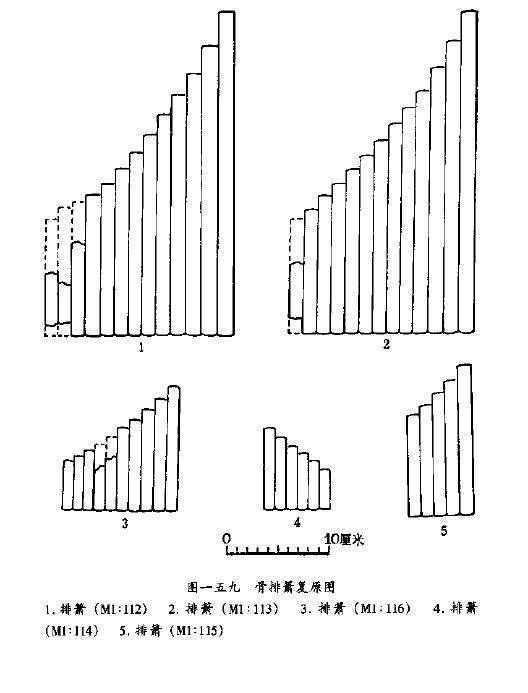
Fig.159 Sketches of the bone panpipes restored
1. 排箫(M1:112) Panpipe (M1:112)
2. 排箫(M1:113)Panpipe (M1:113)
3. 排箫(M1:116)Panpipe (M1:116)
4. 排箫(M1:114)Panpipe (M1:114)
5. 排箫(M1:115)Panpipe (M1:115)
According to the original excavation report, a total of 5 panpipes were discovered. This report was prepared by Mr. Bai Rongjin from the Institute of Archaeology, Chinese Academy of Social Sciences.
There is no denying that the panpipe is of extraordinary value and significance in the history of music.
It was invented as far back as in remote antiquity. The textual record about Ling Lun, the legendary musician in Chinese history who invented music in “Ancient Music”, Master Lü's Spring and Autumn Annals (Lüshi Chunqiu), is the earliest of this instrument in the history of music. During the reign of Zhuanxu, one of the legendary Five Emperors, the panpipe dance music Chengyun (lit. “Bearing Clouds”) was composed, imitating the sounds of “wind from the eight directions”; during the reign of Shun, an early sovereign, the music became so immensely popular that it was included in the "music of metal and stone" (jinshi zhiyue). During the reign of Yu, founder of the Xia Dynasty, the panpipe was also one of the major instruments for dance music. The tradition was carried on in the Shang Dynasty. The discovery of the bone panpipes with bronze nao and stone chimes in Changzikou Tomb proves that in this period the panpipe co-existed with bamboo and stone instruments, both wind and percussion ones.
After the Duke of Zhou established rites and music and proposed that the two should be employed to edify the world, the panpipe achieved great progress. In the Zhou Dynasty, the ya panpipe was used exclusively in "elegant" court music, whereas the song panpipe was used in music played at sacrificial ceremonies for kings and monarchs. The late Spring and Autumn Period saw the crumbling of the ritual and musical system. In the midst of the drastic cultural transformation, the panpipe lost its prevalence in mainstream music. Since then, it has not evolved much in terms of shape. And its status in the band has not been so important than in its former glorious days.
In the Han Dynasty, the music of bells and chimes became less predominant. Panpipes were widely seen among common people. That is why they have been so frequently represented in stone carvings representing music and dance scenes found in Shandong, Henan, Jiangsu, etc. The concurrent use of the panpipe and tao drum (a type of small drum) was extremely popular in the Han Dynasty.
The Qin, Han and Tang dynasties saw the heyday of the panpipe. With the cultural integration of different ethnic groups and the prosperity of Buddhism and Taoism, panpipe naturally became a major instrument of “sacred music”. It has been found in many places in numerous murals representing musicians, flying apsaras (feitian), religious services, etc., including those in grottos.
In the elegant court music of the Southern and Northern, Sui and Tang Dynasties, the panpipe had invariably played a fairly important role, particularly in The Nine Genres of Music (Jiubu Yue) of the Sui Dynasty and The Ten Genres of Music (Shibu Yue) of the Tang Dynasty. In Zhang Sheng’s Tomb in Anyang, Henan, the combination of the panpipe and pipa appears in the section of sitting musicians. From the figures, we can get a clear picture of court music of the Sui Dynasty.
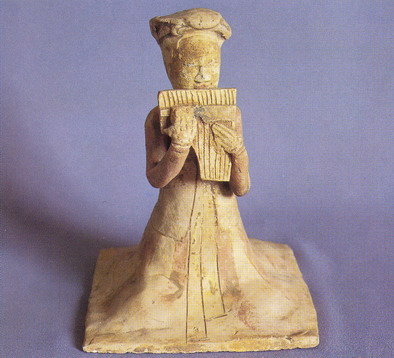
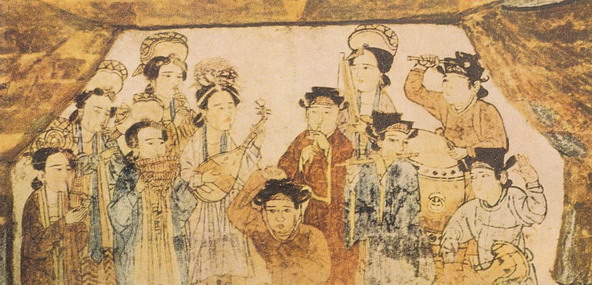
Before the Tang Dynasty, the panpipe had been referred to as “xiao” (now Chinese equivalent for “flute”). Since the Tang and Song Dynasties, because of the increasing prevalence of the flute, the Chinese name panpipe, “xiao”, has been changed to “paixiao” to distinguish the two.
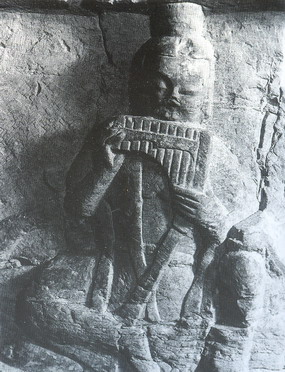
The evolution of the panpipe into the exquisite duxiao panpipe was completed in the Yuan and Ming Dynasties. The new type of panpipe consisted mostly of 16 pipes, arranged and secured in a row by a wooden rack which was usually lacquered and adorned with golden phoenixes. There are relevant records in Essentials of Music (Lülü Jingyi) by Zhu Zaiyu, a Ming scholar. The Qing Dynasty saw the "single-phoenix-wing" arrangement of progressively shortened pipes change into a symmetric “double-phoenix-wing” arrangement of pipes tuned according to the cadence specifications. The wooden rack used during the Yuan and Ming Dynasties was still kept, which was coated with red paint and ornamented with the design of golden dragons.
The Yuan, Ming and Qing Dynasties saw the panpipe in its last days. While dongxiao (a vertical flute) managed to sustain itself, the panpipe could hardly been found. In the Qing Dynasty, it was very hard to hear panpipe music in the Central Plains. Now in the musical instrument museum of the Music Research Institute, China Academy of Art, there is a rare panpipe made during Emperor Qianlong’s reign in the Qing Dynasty. It consists of 16 pipes, each of which bears its respective musical alphabet, for example, the 12 pitches and quadruple pitches With exquisite craftsmanship and over 4,000-year history of the Chinese panpipe, this image was selected as the musical emblem of China by the Ministry of Culture and Chinese Musicians’ Association in 1956.
The panpipe has been grown from the soil of China. Both the two have the same elegant poetic associations. Listening to the panpipe, you are virtually listening to music flowing from the soul of the Chinese nation.
This is the stone panpipe made in the mid and late Spring and Autumn Period and unearthed in Chu Tomb No. 1 in Xiasi, Xichuan County, Henan Province in 1978. Roughly triangular, it is made of white hard stone. It consists of 13 round-holed hollow pipes aligned at one end, whose lengths decrease progressively. The oblique binding ribbon was carved in the middle of the pipes. The wall of the pipes is 1.0cm thick and the average space between every two neighbouring pipes is below 0.1 cm. The longest pipe is 15cm long, while the shortest is 3cm long. The depths of the pipe holes and the lengths of the pipes vary. However, none of them are pierced at both ends. Except for the 7th pipe with a broken mouth, all the rest 12 pipes can still produce sounds of different pitches.
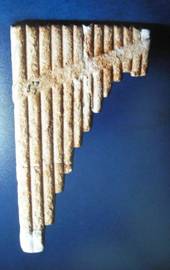
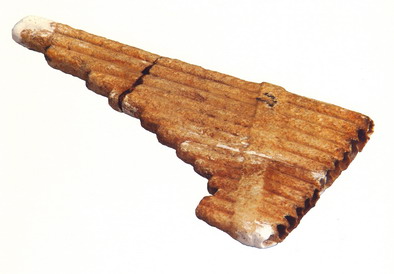
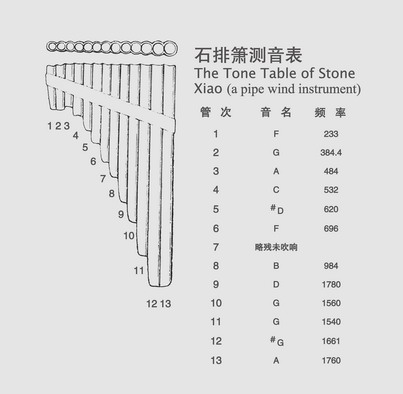
管次 Pipe number
音名 Musical alphabet
频率 Frequency
略残未吹响 Broken, cannot produce sound
Tone table of the stone panpipe unearthed in Chu Tomb No. 1 in Xiasi, Xichuan County, Henan Province
In 1978, two bamboo panpipes made in the early Warring States Period were unearthed from the Tomb of Marquis Yi of Zeng in Suixian County, Hubei Province. Both of them are made of 13 bamboo pipes varying in length. Arrayed in an orderly manner, the pipes are aligned at one end and shorten progressively at the other. They are bound together with three bamboo slips. The surface of the instrument is decorated with red triangular spiral patterns on a black ground. Identical in design but varying in length, the pipes can still give out crisp musical sounds. When played together, it reminds people of a male-female duet. After their excavation, optical instruments detected some remnants of beeswax on the bottom of the pipes, which proves that ancient Chinese did use beeswax to adjust the pitch. In ancient Chinese bands, panpipes were indeed used to tune other instruments. It can be seen that ancient musicians had a good command of this technique. With the comparison between the tone row of the bamboo panpipe and that of the set bells unearthed in the Tomb of Marquis Yi of Zeng, we can find that they have the consistency in their tone-row structures.
C28管数 1 2 3 4 5 6 7 8 9 10 11 12 13
按下徵调 G A C D E G A C D E G A C
Pipe number of C28
Tone (xiazhidiao):
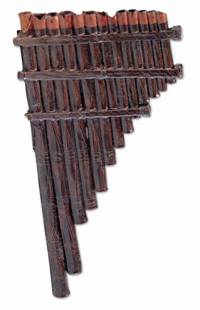
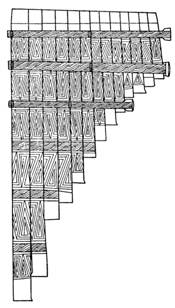
Bamboo panpipe unearthed from the Tomb of Marquis Yi of Zeng in Suixian County, Hubei Province
Outline drawing of the bamboo panpipe unearthed from the Tomb of Marquis Yi of Zeng in Suixian County, Hubei Province
By means of “over-blowing”, the pitch of the panpipe may be raised by one to two octaves. As the coordinating instrument of the music of metal and stone, its role cannot be neglected. In the band, the actual pitch may vary in a two-degree range. That is to say, the panpipe unearthed in the Tomb of Marquis Yi of Zeng with the five-tone scale may play seven-tone music and even produce inflexions in some ranges.
Compared with the above-mentioned panpipes of different materials, the bone panpipe unearthed from Changzikou Tomb in Henan was produced earlier in time with older materials. Its appearance has provided us with a physical evidence to learn and study the evolution and development of the history of music in the late Shang and early Zhou Dynasties, the rules of established scale, serial instruments, musical aesthetics, band assembly and social transformations at the time, thus of great historical and artistic values.
What kind of bird leg bones was the panpipe unearthed from Changzikou Tomb, Henan Province, made of?
Your answer please, if you have any questions or answer, please feel free to send us email, we are waiting for your answers and participation, and your comments, answers and suggestions will be highly appreciated. We will select and publicize the most appropriate answers and comments some time in the future.
Weekly Selection Email: meizhouyipin@chnmus.net
Different Types of Traditional Chinese Musical Instruments
Traditional Chinese musical instruments have a long history. Over 3,000 years ago, a large variety of fairly exquisite musical instruments had been invented in China, for example, the bell, chime, pottery xun (wind-instrument), stone xun (wind-instrument), drum, ling bell, duo (a type of big bell), nao, yue (a type of instrument similar to the panpipe), he (or big sheng, a type of wind instrument), and yan (big flute). In the Zhou Dynasty and Spring & Autumn and Warring States Periods, the number of musical instrument varieties increased to over 80. In the Qin and Han Dynasties, the Three Kingdoms Period, the Jin, Southern & Northern, Sui and Tang Dynasties, thanks to the creativity of people of different ethnic groups and the increased exchanges between different cultures from home and abroad, the cross flute, di (now xiao flute), crooked-necked pipa (predecessor to the current pipa), bili (now known as guan, a type of wind instrument), bronze drum, jie drum, waist drum, etc. emerged.
Later some of these instruments spread all over China and became important for national Chinese music. In the Five Dynasties and the succeeding Song, Yuan, Ming and Qing Dynasties, the thriving folk art brought in many new varieties of musical instruments: percussion instruments such as the yunluo (chiming gongs), small octagonal drum, wooden clappers and cymbalo (yangqin); a wind instrument known as sona; a plucked instrument called sanxian (lit. “three-stringed”); stringed instruments including the erhu, banhu, jinghu and zhuihu. Some new instruments were invented by folk people in the early 21st century, including houguan (wind instrument), yuehu (stringed instrument), etc., which have been used to accompany opera performances.

A graduate from Wuhan Conservatory of Music; a museologist and executive of Huaxia Ancient Orchesta in Henan Museum.
